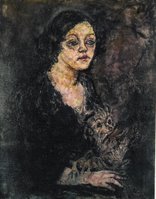Below is a timeline of Alma Mahler's life, which should further illuminate events in the play:
1879-Alma Mahler is born in Vienna on August 31 to Emil Jakob Schindler and Anna Sofie Bergen.
1881-Alma's mother has an affair and gives birth to her half-sister, Grete.
1892-Alma loses her father at the age of 13. Max Burkhard, Director of Burgtheater, lends his support to the family.
1897-Alma's mother marries Carl Moll, Schindler's student. This same year Alma fall's in love with her music teacher, Alexander von Zemlinsky.
1898-99-Alma meets 35-year-old painter Gustav Klimt and they fall in love with each other. She tells no one of the affair, but records it in her diary, which her mother later reads. After a fight between Klimt and Carl Moll, Alma is forbidden to see him.
1900-01-Alma meets Gustav Mahler for the first time on November 7, 1901, after already knowing of Mahler and admiring him. On December 25, 1901 they are engaged.
1902-03-Alma becomes pregnant and they marry on March 9, 1902. Alma gives birth to daughter Maria Anna on November 3, 1902.
1904-Alma gives birth to Anna Maria on June 15, 1904. Anna is known as "Guckie."
1904-07-Alma's life is consumed with Gustav and her children. She is forbidden to compose and must not receive any visitors unless Mahler is present. Daughter Maria dies of scarlet fever and diphtheria in 1907. At the end of July of 1907, Mahler finds out about his heart condition.
1910-For two months, Alma goes to the "thermal health spa of Tobelbad" (103), where she meets architect Walter Gropius. He falls in love with Alma and intends to ask Mahler to marry her. Instead, however, he seeks help from Sigmund Freud. Alma remains committed to Gropius.
1911-12-Mahler dies on May 18, 1911 from cardiac problems. Gropius goes to Vienna to meet Alma, but their relationship cools off. They continue to write. Alma visits Gropius in Berlin in 1911, but Gropius cannot handle the "presence of Gustav Mahler in her life" (104).
1912-15-Alma has a love affair with Kokoschka.
1915-Alma marries Walter Gropius.
1916-Birth of their daughter Manon Gropius.
1918-Beginning of a relationship with Franz Werfel. Her son Martin Carl Johannes is born, but dies in 1919.
1929-Alma marries Franz Werfel.
1935-Alma's daughter Manon dies.
To see photos of Alma, as well as paintings and sketches of her by Kokoschka, click below:
http://www.flickr.com/photos/74644976@N00/sets/72157594383857659/See this link for more Alma information. Although I am not endorsing the following website as God's Truth, you can use this information as a guide to Alma's history. The photos are great:
http://www.alma-mahler.at/engl/almas_life/almas_life.htmlThe timeline above was taken from:
Weidinger, Alfred.
Kokoschka and Alma Mahler. Munich: Prestel, 1996.


